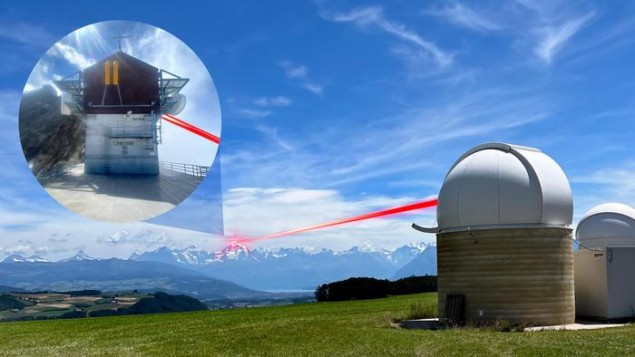
Researchers in Switzerland have transmitted and received optical data at rates of more than 10 Tbit/s between an Alpine peak and an observatory at the University of Bern – a distance of 53 kilometres. This is more than five times further than would be needed to set up a satellite-to-ground communication link, and the team say the method could be used to create faster and more cost-effective Internet connections for satellite constellations in near-Earth orbit.
Satellite constellation systems such as SpaceX’s Starlink (a network of more than 2000 satellites orbiting close to the Earth) promise to bring Internet access to the world via space-based laser communications. The principle is that areas that do not have access to optical-fibre cable technology, which makes up the backbone of the modern Internet, could instead become connected to the optical network via satellites.
At present, data transmission between satellites and ground stations relies mainly on radiofrequency technologies, which operate in the microwave range of the electromagnetic spectrum and have wavelengths of centimetres. Laser optical systems, in contrast, operate in the near-infrared range, and their micron-scale wavelengths are about 10 000 times shorter than radio waves. This enables them to transport more data in the same amount of time. Indeed, several previous experiments have shown that free-space optical communication technologies can transmit data at rates of 100 Gbits/s over distances of up to 10 km and 1 Tbits/s over distances of up to 3 m in a single channel.
The downside is that such systems rely on advanced high-order modulation formats and therefore require high signal-to-noise ratios, which are only possible over relatively short distances. Future satellite links will also require even higher data rates, on the order of 500 Gbits/s or more.
A scenic experiment
In the new work, researchers led by Juerg Leuthold, the head of the Department of Information Technology and Electrical Engineering (D-ITET) at ETH Zurich, established a satellite optical communications link between the High Altitude Research Station on the Jungfraujoch and the Zimmerwald Observatory near Bern. In doing so, they showed that a laser beam could efficiently propagate through atmospheric turbulence that would normally adversely affect the movement of the light waves, and thus the transmission of data.
The researchers achieved this feat by modulating the laser’s light wave in a way that allowed the receiver to detect different states encoded into a single “symbolâ€. This means that each symbol can transmit more than one bit of information. For example, a scheme comprising 16 states can transmit four bits with each oscillation of the light wave, while one with 64 states can transmit six bits.
“Several key components enabled this success,†says study lead author Yannik Horst. On the transmitter side, he explains that the team encode the information in a power-efficient way by using a coherent modulation format such as a polarization-multiplexed 64-quadrature-amplitude-modulation (64-QAM). They then send it with very high precision (a few tens of micro-radians) in the direction of the receiver at the observatory. Finally, after the light passes through 53 km of turbulent atmosphere, an adaptive optics system at the receiving station corrects the phase front error of the electromagnetic wave.
“The adaptive optics leads to ~300 times stronger signal in the optical fibre,†Horst tells Physics World. “The improvement also comes thanks to the optical building block that has a high receiver sensitivity – only a few photons per bit are needed for error-free data transmission.â€

Down to earth
Horst and colleagues say their new technique should bring us a step closer to satellite-Earth and inter-satellite communication links based on optical technologies that can achieve very high date-rates per channel – much higher than is possible for radiofrequency technologies. Such links could one day act as the backbone for the terrestrial fibre network and ultimately “connect the unconnected†in areas where the deployment of mainstream communications technologies such as optical fibre is not feasible.
The researchers, who report their work in Science, are now investigating a novel modulation format known as 4D-BPSK. “We believe this format could be applied to other optical applications thanks to its very high sensitivity too,†Horst says.


